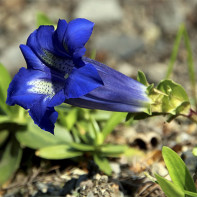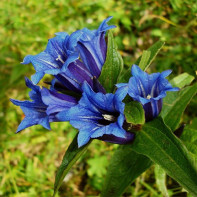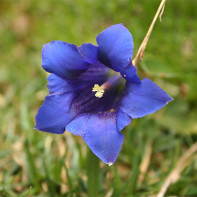Gentian: medicinal properties and contraindications
Gentle blue, violet, yellow gentian bells open in spring or autumn, inviting herbalists for a walk for a useful plant. Its medicinal properties were used in the 2nd century BC, curing plague with rhizomes. The ground part is also appreciated and used in many folk recipes.
- How it looks and where it grows
- Kinds
- Collection and storage
- Chemical composition
- The healing properties of gentian
- The use of gentian in folk medicine
- Nervous exhaustion and chronic fatigue
- Lack of appetite
- Rheumatism, arthritis, gout
- Hyperhidrosis
- Heartburn
- Diathesis
- Gentian cultivation in the garden
- Contraindications
How it looks and where it grows
In total, the family has 400 species. In the European part, 96 of them are common. They have common features, but differ in size and flowering period. The smallest representatives grow no higher than 20 cm, and giants reach 1.5 m. These are mainly shrubs with straight stems and powerful rhizomes. The leaves are long, lancet, with a pronounced hollow in the middle of the leaf plate.
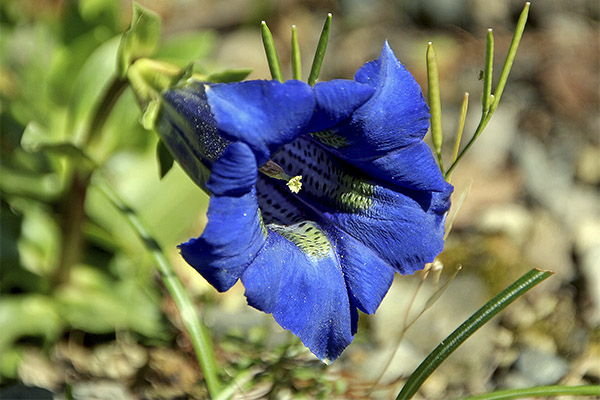
The corolla of the flower is most often colored in purple, blue, yellow or white. A darker shade prevails inside, the outer side is lighter, often there are stripes extending from the base to the edges of the petal. Compared to the length of the stems, the flowers are large, similar to a bell.
The habitat covers almost the entire globe, excluding the most northern areas. But most likely, gentian or bitterness, as it is called in our country, grows in temperate latitudes. Moreover, she is not afraid of heights and rarefied air, sometimes climbing to the mark of 5500 m above sea level. It is often found in alpine meadows as part of forbs. The bitterness almost does not form glades, focusing on 3-4 bushes.
As a medicinal plant, it has been grown for a long time in pharmaceutical gardens so as not to run after medicinal raw materials on the mountains and hillsides. It has a good decorative effect, is planted separately or as part of flower beds. You can combine varieties with different flowering periods, and provide an all-season flowerbed with unusual delicate bells, receiving double benefits - aesthetic pleasure and easy collection of the necessary raw materials.
Kinds
There are annual and perennial varieties. In horticulture, perennials are preferred, in medical practice several main types are used:
- stemless;
- spring;
- pulmonary;
- Daurian;
- cross-leaved;
- yellow;
- large-leaved.
Species are characteristic for different natural conditions, in most they are not afraid of frost and do not require close attention when growing. They are collected in natural conditions or cultivated in summer cottages and household plots.
Important: some types of gentian are considered rare and endangered due to human activities.
Spring
The smallest, grows no more than 3-5 cm. One bright blue flower is revealed on a straight stem. The plant is perennial, it is not afraid of frosts, it is undemanding to the growing conditions, it has analgesic, bactericidal and mild sedative effects. In folk recipes, rhizomes and leaves are used.
Stemless
The stem rises 9-10 cm above the ground, the flower is large, brightly colored, bell-shaped. It grows in one place for several years, resistant to frost.
Interesting: it can be used to predict the weather, a few hours before the rain, the flower corollas close.
Pulmonary
The height of the plant is 60 cm, the stem is one, does not branch, narrow leaves sit tightly, arranged in frequent tiers. Blue bell-shaped flower. At the top of the stem at the end of summer, 1, rarely 2, flowers are revealed with characteristic dashed lines on the outside.
In folk medicine, ground parts and root are used.It is used to expel parasites from the intestines, stabilize the nervous system, reduce pain during menstruation, and normalize uterine tone.
Daurian
It differs from the rest in flowers, collected in inflorescences of 5-8 pieces. They are located 2-3 tiers on a stalk almost leafless. Mass flowering occurs in August. The main part of the leaf plates grows from the basal rosette. They surround the stem, which rarely extends above 40 cm.
Decoctions and infusions from the roots and the ground part have antipyretic, immunostimulating, antibacterial action. They are used for rheumatism, muscle pain, to reduce soreness during injuries, relieve vascular spasms and migraine attacks. A good antiviral effect allows it to be used during viral influenza epidemics, SARS. Decoctions are recommended for men as a supportive tool for constant stress and emotional fatigue. Regular use of gentian returns potency, restores the mechanism of sexual arousal.
Cross leaf
One of the most valuable from the point of view of herbalists. The recipes use the root. The plant prefers rocky slopes, open sunny places. It feels great in the neighborhood with other meadow herbs. The shrub reaches a height of 70 cm. It is characterized by unbranched straight stems with a powerful basal rosette of leaves. Flowers are formed by bunches in the axils of the leaves. They begin to unfold almost simultaneously, starting from the lower tiers. Flowering occurs in the summer, starting in the second half of June, the seed box is formed in September.
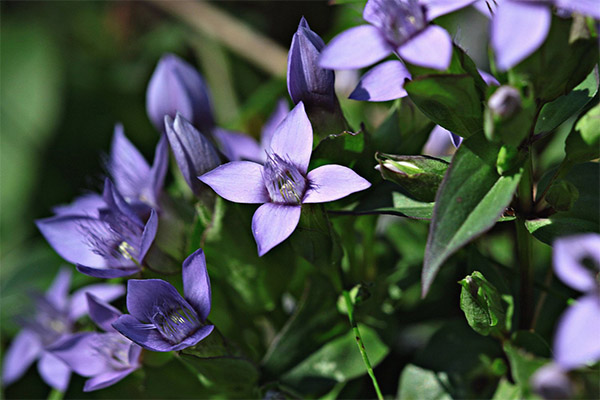
Rhizomes include alkaloids, bitterness and essential oils. Infusion and decoction of them are used for problems in the digestive tract, heartburn, polyarthritis, anemia and poor appetite. Lotions and compresses stimulate regeneration in case of weeping and purulent wounds, the powder mixed with chamomile flowers is effective in case of skin damage.
With foot hyperhidrosis, rhizomes are used along with crushed oak bark.
Yellow
It was used in ancient Greece and Rome to normalize digestion, rhizomes were used to treat plague and prevent intestinal diseases. The most rare, endangered species, is listed in the Red Book. It is difficult to cultivate, disappears in nature, because it can live only in certain places, which are often mastered by man.
The tallest species, reaches 1.5 m, from the rhizome there are several powerful straight stems. The leaf color is green with a bluish tint; relief arc veins are clearly visible on the surface. The lower ones are collected in a fluffy outlet, the upper ones are arranged in pairs on the stem. Blooms profusely, starting from 3-4 years of life. Under favorable conditions, the shrub lives up to 50 years. Rhizome is appreciated, decoctions, infusions, extracts for ointments are prepared from it.
It is used as a disinfectant, antiviral, antibacterial agent. It is used in single-compound recipes and collections for gastritis, achilles, disorders of the gallbladder and liver. Decoctions of rhizomes enhance immunity, accelerate regeneration, have a sedative effect. Recommended for pulmonary pathologies, urolithiasis, disorders in the sexual sphere.
Large leaf
Distributed in Siberia, the Far East, in the Amur region. In addition to medicinal properties, it is a honey plant. The name fully reflects the appearance of the plant. The leaves, unlike other species, are really large, numerous. 2.5–3 cm grow in width, sometimes reaching 40 cm in length. Many of them are located in the basal zone, as the stem is pulled, the number of leaves gradually decreases with height. Flowers, on the contrary, are small, about 2 cm in diameter, of intense blue color with a violet tint. Popular as an ornamental plant in multi-tiered flower beds.
For medicinal purposes, all parts of the plant are used, but after collection they are neatly divided into the ground part and rhizomes, dried separately. Decoctions improve digestion and potency, are used as a hemostatic and antibacterial agent.Infusions are good for regulating the secretory function of the stomach, eliminating the pathogenic flora in the digestive tract, and improving intestinal motility.
It is also used to treat pulmonary diseases, hypertension, neurasthenia, chronic gastritis.
Collection and storage
Gentian grows in small curtains of several bushes. They plan a place to gather in the summer, choosing glades with the most leafy basal rosettes. If the culture is grown on a personal plot, then it is worth planting several beds and collecting raw materials from them alternately, be sure to leave a small part for further growth.
Important: Plants have a medicinal effect only after 3-4 years; younger ones have not yet accumulated a complex of useful substances.
In most species, rhizomes along with roots are considered the most valuable component. Those varieties in which the ground part is also used are recommended to be collected in 2 doses. The green mass is partially cut during flowering, and the roots are dug up in the fall, after the beginning of the wilting of the leaves.
After the rhizome is dug up, it is thoroughly shaken, thin roots, damaged areas are trimmed and only then washed in several waters. Small roots are dried whole, longer are cut into pieces, and those that have reached a thickness of 2-3 cm, it is better to divide along. It is more convenient to dry at a temperature of 50 degrees. An electric dryer is used for this. With natural drying, the process of gradual fermentation begins, and part of the useful bitterness is destroyed. Qualitatively dried rhizomes can be identified by a light honey-grassy smell and a very bitter taste.
Shelf life of finished raw materials is 3 years. After drying, it is best to place the rhizomes in a linen bag and hang in a dry, dark place, noting the year and month of collection.
Chemical composition
For each species, the ratio of nutrients varies slightly, but the common ones are:
- Kakhetins;
- pectins;
- bitterness;
- gum;
- flavonoids;
- resins;
- mucus;
- tannins;
- iridoids;
- sucrose;
- essential oils;
- fatty acid;
- coumarins;
- gentian;
- alkaloids;
- ascorbic acid.
Coloring is given to the root by colorants. The level of therapeutic effect is due to the presence of bitter glycosides concentrated in the rhizome.
The healing properties of gentian
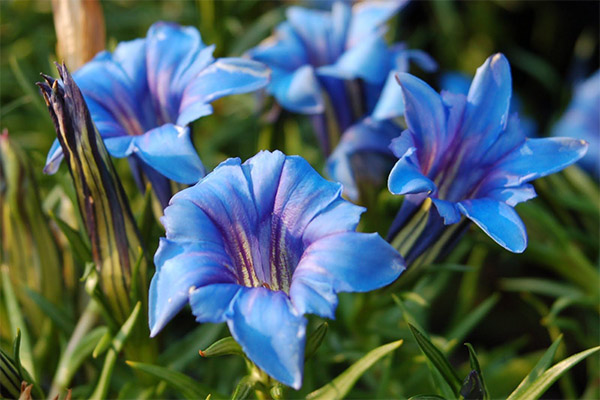
Decoctions and infusions of the root part are used as part of complex therapy:
- with a low level of appetite;
- anemia
- anemia;
- diathesis;
- vitamin deficiency;
- scurvy;
- bronchitis;
- chronic cough;
- loss of strength;
- low immunity and delayed regeneration;
- joint pain.
Decoctions of herbs and rhizomes have been successfully used to treat plague and malaria due to their antibacterial and anti-inflammatory properties. Yellow gentian is included in the composition of gastric elixirs, Bittner balsam, Swedish bitterness, Aflubin. Poultices and lotions help relieve itching and irritation with hives, insect bites, and are effective in treating festering wounds and cuts.
The main direction of use of gorchanka is a malfunction in the digestive tract. It relieves spasms of smooth muscles, eliminates constipation, flatulence and heartburn, stimulates the separation of bile, secretion of the digestive glands.
The use of gentian in folk medicine
Rhizomes and leaves are used for internal and external use, depending on the type and severity of the disease. Basically, water infusions are prepared, less often alcohol. Decoctions retain useful properties only for a day, even if stored in the refrigerator. You need to cook them in small portions, and what is left will have to be poured in 24 hours. The powder from the dried rhizome is best stored; it must be placed in a jar with a well-ground lid to protect it from moisture.For each segment of the disease there are effective and time-tested folk recipes.
Nervous exhaustion and chronic fatigue
For 200 ml of water, take 2 tbsp. tablespoons of dry raw materials, over low heat, bring to a boil and incubated for 10 minutes. Then it is cooled, filtered and divided into 4 equal parts, which are consumed during the day. The course of treatment is at least 14 days.
Lack of appetite
Reception options 2, in broth and powder. With complete reluctance to eat food, it is recommended to take powder 3 times a day at the tip of a knife, washing down with 100 ml of warm water half an hour before the planned meal.
For milder symptoms, it is better to give preference to a decoction of 1 tbsp. water for 1 teaspoon of raw materials. The simmering time in an enameled pan over low heat is 10 minutes. Take 20 ml for 15-20 minutes before eating. The remaining funds are poured in the evening, the next day a new portion is prepared.
Rheumatism, arthritis, gout
The crushed dry root is poured into 300 ml of cold water and after boiling it is simmered for 15 minutes. After the broth is left for 2 hours, it is filtered, poured into a bottle or jar with a lid. Take in equal portions 3 times a day. The tool is not addictive, with regular use it relieves joint pain, reduces the intensity of gout attacks, increases the flexibility and amplitude of movement of the limbs and lumbar.
Hyperhidrosis
The smell of sweat is easily stopped by daily baths from a mixture of 5 parts of gentian rhizome and 3 parts of crushed oak bark. Raw materials are poured with 1 liter of water, boiled for at least 10 minutes. The broth should be warm as soon as the leg suffers. The procedure is carried out until the liquid cools. The feet get wet with a cotton cloth, natural fiber socks are put on at night. Within 3-4 days, the smell disappears, after a week of procedures, sweating is significantly reduced. At this time, it is advisable not to use socks and tights made of synthetic fabrics.
Heartburn
Instead of pills, it is much better to take a glass of root tincture on wine or vodka before eating. Infusion is prepared 21 days from 1 tbsp. tablespoons of crushed rhizomes per 200 g of liquid.
Diathesis
Its manifestation in an adult is especially annoying, but it is difficult to deal with it. To relieve external symptoms, a decoction is prepared from a mixture of yarrow herb, gentian roots and elecampane in equal shares. 15 g of mixed raw materials are poured into 500 ml of water and boiled for 10-12 minutes. Accepted only in the form of heat before eating 1 tbsp. spoon.
Gentian cultivation in the garden

In addition to medicinal species, there are also decorative varieties of amazing beauty. It is good to combine them, then when removing part of the medicinal plants, the appearance of the flower bed will not suffer much. Undemanding to growing conditions and such spectacular species:
- sevenfold;
- Chinese decorated;
- ciliary;
- point;
- narrow-leaved.
Experienced gardeners advise not to mess with seedlings, but to sow the crop immediately in the soil warmed by the spring sun in early May. For species with a spring flowering period, shaded areas are chosen, for autumn - sunny. Small seeds are sown on prepared soil and lightly sprinkled with a very thin layer of sand.
Plant care is minimal and consists in timely watering, cultivating and removing weeds. It is not necessary to feed with special preparations; it is enough to pour 3-4 times per season with ash water or a very weak infusion of mullein. In one place, bitterness can grow up to 10-12 years. For winter, in areas where there is little snow, and frosts come on sharply and for a long time, a plantation with a medicinal plant is covered with coniferous spruce branches.
During the flowering period, the gentian is the most vulnerable and demanding for watering. It is best if the soil on its bed is constantly slightly moist.
Sometimes dots or bloom appear on the bushes. These are signs of gray rot, brown spotting or rust.
Important: a plant with signs of disease cannot be used for medicinal purposes.
With a small area of damage, fungicides are treated, with significant damage to the green mass, the plant will have to be destroyed, and the place of growth should be treated with a solution of lime.
Gentian is not immune from the appearance of pests, and the bitter taste of the plant for them does not become a serious barrier. Thrips, aphids, slugs, nematodes occasionally appear on the bushes. The fight against them is through spraying with insecticides. Fufanon, Aktara, Karbofos are especially effective.
Please note: most of the drugs are poisonous to bees, so if there is an apiary nearby, then you will have to do with folk methods.
Contraindications
An obstacle to the use of any kind will be intolerance to bitterness, pregnancy and lactation. With caution, decoctions and infusions are used for possible allergic reactions. To determine, you need to apply a little tool on the back of the brush. If redness or itching is observed within 2-3 hours, then you will have to refrain from such treatment. High blood pressure, peptic ulcer and hyperacid gastritis in the acute stage are also considered contraindications.
A useful and beautiful plant - gentian - will become a decoration of the garden and at the same time a green first-aid kit.
«Important: all information on the site is provided exclusively in fact-finding purposes. Before applying any recommendations, consult with a profile specialist. Neither the editors nor the authors are liable for any possible harm caused materials. "

